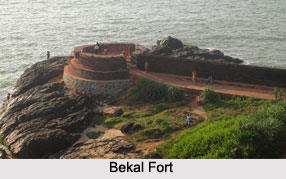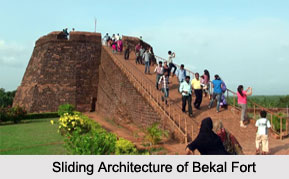 Bekal Fort is an ancient Indian fort which is situated in the district of Kasaragod in North Kerala. It is the largest fortress in the India state of Kerala and covers a total area of 40 acres. The geographical coordinates of Bekal Fort are latitude 12.3667°N and longitude 75.05°E. The site offers a panoramic view of the landscape and the towns of Bekal, Uduma, Kottikkulam, Pallikkara, Kanhangad and others cane be viewed from the observation tower in the fort. It was raised mainly as a defensive structure and the architecture reveals the defence strategy of the fort. The fortress was not used as an administrative centre, unlike most of the other forts in the country. The exterior walls and ramparts of the building were particularly designed to protect the main fortress and its occupants.
Bekal Fort is an ancient Indian fort which is situated in the district of Kasaragod in North Kerala. It is the largest fortress in the India state of Kerala and covers a total area of 40 acres. The geographical coordinates of Bekal Fort are latitude 12.3667°N and longitude 75.05°E. The site offers a panoramic view of the landscape and the towns of Bekal, Uduma, Kottikkulam, Pallikkara, Kanhangad and others cane be viewed from the observation tower in the fort. It was raised mainly as a defensive structure and the architecture reveals the defence strategy of the fort. The fortress was not used as an administrative centre, unlike most of the other forts in the country. The exterior walls and ramparts of the building were particularly designed to protect the main fortress and its occupants.
History of Bekal Fort
The Bekal Fort was built in 1650 AD by Sivappa Nayaka of Bednore. The region of Bekal was included as a part of Mahodayapuram during the Perumal era. After the fall of the Perumals of Mahodayapuram in the 12th century AD, entire North Kerala, including the region of Bekal, came under the rule of the Chirakkal Royal Family. During the reign of the Kolathiri Rajas, the territory was developed as a prominent port town of Malabar and Tulunadu and the significance of Bekal increased to a great extent.
After the decline of the Vijayanagar Empire in the Battle of Talikota in 1565, the Keladi Nayakas and various other feudatory chieftains gained political dominance. The Nayakas attacked and seized Tulunadu after realizing the economic and political importance of the region. The economic significance of the port town of Bekal encouraged the Nayaka rulers to strengthen and fortify the town. It served as a center in setting up the authority of the Nayakas in Malabar. The fortress was founded by Hiriya Venkatappa Nayaka and the construction of the structure was completed during the reign of Sivappa Nayaka.
Later Hyder Ali, the ruler of the Kingdom of Mysore, defeated the Nayakas and conquered over the fort and the port town of Bekal. Under the rule of Tipu Sultan of Mysore, it was utilized as a prominent military post during the military campaign to seize Malabar. After the death of Tipu Sultan of Mysore in the Battle of Seringapatam during the Fourth Mysore War in 1799, the British East India Company took control over Bekal Fort.
 The region was developed as the headquarters of Bekal Taluk in undivided Dakshina Kannada District in the former Bombay Presidency. In 1799, Dakshina Kannada or South Canara was incorporated as a part of the Madras Presidency. Eventually the economic and political significance of Bekal fort and the port town declined substantially.
The region was developed as the headquarters of Bekal Taluk in undivided Dakshina Kannada District in the former Bombay Presidency. In 1799, Dakshina Kannada or South Canara was incorporated as a part of the Madras Presidency. Eventually the economic and political significance of Bekal fort and the port town declined substantially.
Architecture of Bekal Fort
Bekal Fort was renovated and modified several times under the reigns of several rulers from different dynasties. The fortress includes a water reservoir with stairs; a secret tunnel that leads towards the southern direction; a warehouse for storing weapons and ammunitions; and an observation tower with wide stairs which was located at the centre of Bekal Fort. The observation post was constructed under the rule of Tipu Sultan. It provides a magnificent view of the coastline. The tower helped in detecting every move of the enemy forces and ensuring the safety of the port town and the fort. There is also a rest house inside the premise of the fort that was built by the British East India Company.
There is an ancient Mukhyaprana Temple of Lord Hanuman and a mosque in the vicinity of the fort. It also includes many trenches and zig-zag pathways that served as a line of defence. The outer walls and ramparts of the structure were especially built to provide protection to the inner portion of the fortress. The exterior walls included many openings or holes that were used to fire weapons at the approaching enemy forces. The openings at top were used to aim at distant points; the openings near the bottom helped in attacking the enemy when they were closer; and the holes beneath were used to attack the rival forces when they were extremely close to the structure.
Present Condition of Bekal Fort
The site of Bekal Fort was declared as a special tourist destination in 1992 by the Government of India. Later in 1995, the Bekal Tourism Development Corporation was formed to develop the area as an international tourist spot. Recently, the Bekal Resorts Development Corporation (BRDC) has been undertaking several activities to promote tourism in Bekal. At present, the fortress is preserved and maintained by the Archaeological Survey of India (ASI).



















